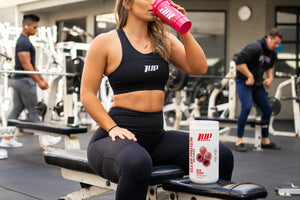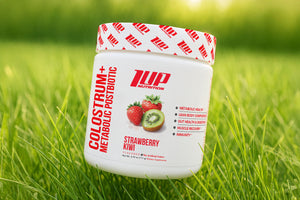Hormones are important signaling/communication molecules within the body that impact numerous aspects of daily living, including mood, sexual health, metabolism, recovery, fat loss, and athletic performance. As essential as hormones are to health, performance, productivity, and well-being, there’s unfortunately a great deal of misunderstanding and misinformation circulating around them.
“Hormones” get blamed for everything from a slow metabolism (and fat gain) to brain fog to anything else you can think of. While hormones are involved in virtually every facet of physiology, simply saying “your hormones are to blame” is a gross oversimplification of what’s really at the root of why you may not be achieving your specific goals -- physical, emotional, relationship, professional, financial, etc.
Today, we look at how women’s monthly fluctuating hormone levels can specifically impact their performance in the gym and to what degree regular hormone changes may have.
Let’s start with a basic overview of the major female hormones that rise and fall each month.
Menstrual Cycle Overview
A “normal” menstrual cycle occurs regularly and lasts between 21 and 35 days. It is divided into two distinct main phases, follicular and luteal.
Follicular Phase
The “early” follicular phase begins with menstruation, which usually takes 4 to 6 days to complete. During this time, sex hormone concentrations (estrogen, progesterone, follicle stimulating hormone, and luteinizing hormone) are relatively low and stable.[1]
The follicular phase continues until ovulation occurs. During the “late” follicular phase, estrogen rises. When estrogen levels reach a critical point, there is increased secretion of gonadotropin releasing hormone, which then causes a rapid rise in luteinizing hormone. This surge triggers ovulation.
Luteal Phase
The early luteal phase begins following ovulation. During this phase, progesterone starts to rise as well as a small amount of estrogen.
The mid luteal phase sees progesterone levels peak in tandem with a second, smaller peak in estrogen. Rising progesterone levels can increase appetite, trigger cravings, and lead to feelings of fatigue while thickening the lining of the uterus.
The luteal phase will end if a fertilized egg implants itself into the uterine lining. If the egg remains unfertilized, progesterone and estrogen both rapidly decline as the cycle prepares to restart. The uterine lining is shed, and the cycle begins again.
Decreasing estrogen levels can play a role in cravings and brain fog, but the drop in progesterone helps boost energy levels.
So, how does progesterone affect physical performance?
The Progesterone Paradox
Based on the overview above, it would seem like progesterone is primarily the “problem child” in regards to athletic performance.
The truth is that estrogen and progesterone are important, and a balance of both is essential to optimal health and performance.
For example, estrogen affects bone health, muscle growth, and blood pressure while progesterone impacts appetite regulation, sleep quality, and brain function.[2,3]
Disruptions in the balance between estrogen and progesterone can lead to:
- Irregular cycles
- Increased fat storage
- Water retention
- Mood swings
- Insomnia
- Migraines
- Anxiety
- Weight gain
- Hot flashes
- Reduced sex drive
With this information, you might be wondering why your natural energy levels and performance can fluctuate so wildly over the course of a month, regardless of how much pre-workout you take before a workout.
Researchers have identified several potential causes for why performance may suffer, including (but not limited to)[1]:
- Altered muscle activation (muscles may fire stronger during certain times of the month)
- Substrate metabolism (how your body uses carbs and fats for ATP production during exercise)
- Thermoregulation
Altered Muscle Activation
Changes in key sex hormones (estrogen, progesterone, etc.) may impact muscle contractile force, which can affect muscle strength and power. For example, estrogen has an excitatory effect in the brain while progesterone has an inhibitory (“calming”) effect.[4] As estrogen falls and progesterone rises, this may limit the muscle’s ability to produce force, thereby impairing your ability to lift heavier weights for more reps.[4,5,6]
Based on this information, researchers posit that greater strength and power output may occur during the follicular phase, especially when estrogen peaks during the late follicular phase.
Lower muscle activation would likely occur in the luteal phase when progesterone is increased.
Interestingly, research has found that lower body muscle activation was significantly higher in the late luteal phase (progesterone > estrogen) compared to the early follicular phase (estrogen > progesterone).[7,8]
Substrate Metabolism
Carbohydrates are the primary fuel for muscles during intense physical activity while fats are the major source of muscle energy during low-to-moderate intensity exercise and at rest. However, it’s not an “all or nothing” situation. Even during high-intensity exercise, a small portion of fat is being oxidized (“burned”) for energy and vice versa.
Technically, estrogen boosts the availability of free fatty acids for fuel during exercise and promotes lipid oxidation (“fat burning”) in skeletal muscle, while progesterone counters the action of estrogen by limiting fat burning.[9]
A small study found that recreational female athletes exercising at “high intensity” displayed lower carbohydrate oxidation and greater fat burning during the mid-to-late luteal phase compared to the early follicular phase. Researchers attributed the unique findings to estrogen levels, which are typically at their lowest during the early follicular phase.
During submaximal exercise, carb and fat burning were similar across the mid-luteal and late-follicular phases.[10,11]
A different study found no significant change in free fatty acid availability and whole-body maximum fat burning in three phases of the menstrual cycle despite significant changes in estrogen and progesterone.[12]
Thermoregulation
Increasing body temperature is a key component of an effective warm up as it primes the muscles, joints, ligaments, tendons, and nervous system for intense exercise. Research confirms that an increased body temperature can aid performance in short-duration exercise that emphasizes speed and power (e.g. resistance training, crossfit, HIIT, etc.).[13]
Based on this, researchers believed that the increased resting body temperature during the luteal phase might enhance performance; however, they found that a “proper” warm up eliminates the between-phase differences in basal body temperature and does NOT affect performance.[14]
During prolonged (endurance) exercise, an elevated basal body temp is thought to reduce endurance performance by way of increased thermal and cardiovascular stress, particularly during the luteal phase.
Other Considerations
Despite the conflicting evidence regarding athletic performance and hormone levels across the different phases of the menstrual cycle, here are some key concepts to consider:
- Water weight: certain times of the month your body will retain more water which can lead to feelings of heaviness, sluggishness, and lethargy, which can impact the way you perceive how you will perform during your workouts.
- Consume a healthy diet: foods rich in B-vitamins, iron, and zinc promote a healthy balance of estrogen and progesterone, which may help you to feel and perform better each and every day
- Take diet breaks every 2-3 months: rigorous dieting (>20% calorie deficits) over prolonged periods can place added stress on your body (and regular hormone production) which can adversely impact your monthly cycle, and thus workout performance, fat burning, weight loss, etc.
- Consider supplements: certain supplements can promote healthy hormone levels and exercise performance. 1UP Hormone Support Plus is an expert-formulated 5-in-1 supplement to support menstrual regulation, stress and mood support, hormone balance, and metabolism.
Takeaway
Hormones are fascinating, complex, and vastly over-simplified across the various social and mass-media outlets. The reality is that hormones are impacted by numerous factors, and lifestyle factors (nutrition, exercise, sleep, etc.) are frequently overlooked as a cause for weight gain, performance drop-offs, and not realizing results.
In fact, the same scientific review mentioned above discussing the impact of the menstrual cycle on female athletes performance found that the different cycle phases “did not produce significant improvements or impairments to physical performance…”[1]
In other words, there were other factors at play (not necessarily solely hormone fluctuations to blame) for performance differences.
Interestingly, all included studies in the aforementioned review reported that a particular menstrual cycle phase impacted the female athletes’ perceived performance. So, how you “feel” or subjectively perceive yourself may impact your workout performance.
In conclusion, hormones may have some impact on how your workout goes, but it’s just one piece of the puzzle. Sleep, nutrition, supplementation, and stress management all play a role in hitting your training goals and getting results from your workouts as well as during your transformation challenge.
References
- Carmichael MA, Thomson RL, Moran LJ, Wycherley TP. The Impact of Menstrual Cycle Phase on Athletes' Performance: A Narrative Review. Int J Environ Res Public Health. 2021 Feb 9;18(4):1667. doi: 10.3390/ijerph18041667. PMID: 33572406; PMCID: PMC7916245.
- Iorga A, Cunningham CM, Moazeni S, Ruffenach G, Umar S, Eghbali M. The protective role of estrogen and estrogen receptors in cardiovascular disease and the controversial use of estrogen therapy. Biol Sex Differ. 2017 Oct 24;8(1):33. doi: 10.1186/s13293-017-0152-8. PMID: 29065927; PMCID: PMC5655818.
- Guennoun R. Progesterone in the Brain: Hormone, Neurosteroid and Neuroprotectant. Int J Mol Sci. 2020 Jul 24;21(15):5271. doi: 10.3390/ijms21155271. PMID: 32722286; PMCID: PMC7432434.
- Smith M.J., Adams L.F., Schmidt P.J., Rubinow D.R., Wassermann E.M. Effects of ovarian hormones on human cortical excitability. Ann. Neurol. 2002;51:599–603. doi: 10.1002/ana.10180.
- Pallavi L.C. Assessment of Musculoskeletal Strength and Levels of Fatigue during Different Phases of Menstrual Cycle in Young Adults. J. Clin. Diagn. Res. 2017;11:CC11–CC13. doi: 10.7860/JCDR/2017/24316.9408.
- Phillips S.K., Sanderson A.G., Birch K., A Bruce S., Woledge R.C. Changes in maximal voluntary force of human adductor pollicis muscle during the menstrual cycle. J. Physiol. 1996;496:551–557. doi: 10.1113/jphysiol.1996.sp021706.
- Tenan M.S., Peng Y.-L., Hackney A.C., Griffin L. Menstrual Cycle Mediates Vastus Medialis and Vastus Medialis Oblique Muscle Activity. Med. Sci. Sports Exerc. 2013;45:2151–2157. doi: 10.1249/MSS.0b013e318299a69d
- Tenan M.S., Peng Y.L., Hackney A.C., Griffin L. Maximal Force and Motor Unit Recruitment Patterns are Altered across the Human Menstrual Cycle; Proceedings of the Poster Session at the Integrative Biology of Exercise VI; Westminster, CO, USA. 10–13 October 2012.
- Oosthuyse T., Bosch A.N. The Effect of the Menstrual Cycle on Exercise Metabolism. Sports Med. 2010;40:207–227. doi: 10.2165/11317090-000000000-00000.
- Hackney A.C., McCracken-Compton M.A., Ainsworth B. Substrate Responses to Submaximal Exercise in the Midfollicular and Midluteal Phases of the Menstrual Cycle. Int. J. Sport Nutr. 1994;4:299–308. doi: 10.1123/ijsn.4.3.299.
- Vaiksaar S., Jürimäe J., Mäestu J., Purge P., Kalytka S., Shakhlina L., Jürimäe T. No effect of menstrual cycle phase on fuel oxidation during exercise in rowers. Graefe’s Arch. Clin. Exp. Ophthalmol. 2010;111:1027–1034. doi: 10.1007/s00421-010-1730-1.
- Frandsen J., Pistoljevic N., Quesada J.P., Amaro-Gahete F.J., Ritz C., Larsen S., Dela F., Helge J.W. Menstrual cycle phase does not affect whole body peak fat oxidation rate during a graded exercise test. J. Appl. Physiol. 2020;128:681–687. doi: 10.1152/japplphysiol.00774.2019.
- Girard O., Brocherie F., Bishop D.J. Sprint performance under heat stress: A review. Scand. J. Med. Sci. Sports. 2015;25:79–89. doi: 10.1111/sms.12437
- Somboonwong J., Chutimakul L., Sanguanrungsirikul S. Core temperature changes and sprint performance of elite female soccer players after a 15-minute warm-up in a hot-humid environment. J. Strength Cond. Res. 2015;29:262–269. doi: 10.1519/01.JSC.0000491321.12969.1d.






